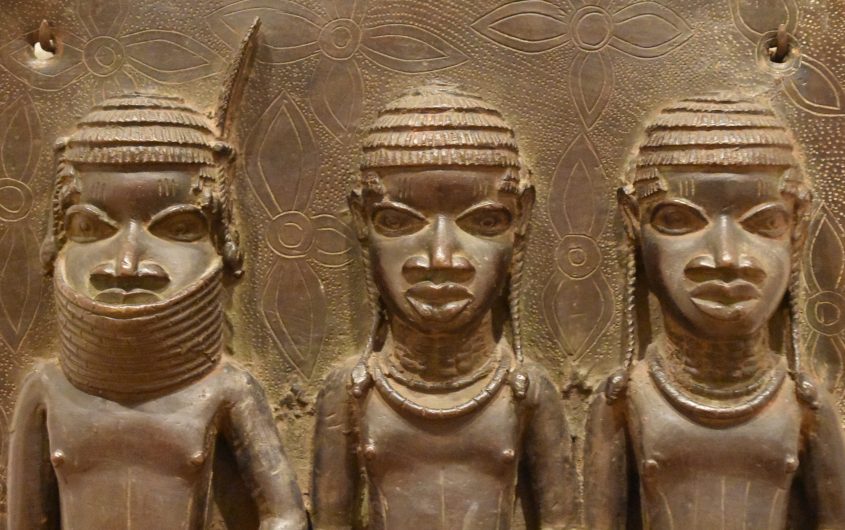
Richard Mortel via Flickr
Germany intends to restitute artworks from the Kingdom of Benin (“Benin Bronzes”) to Nigeria

Katrin Sieg
Georgetown University
Professor Sieg is Professor of German jointly affiliated with the BMW Center for German and European Studies and the German department. She holds a Ph.D. in Drama from the University of Washington, Seattle, and taught at UC San Diego and Indiana University, Bloomington, before joining Georgetown University in 2002. Her research focuses on German and European culture, postcolonial and critical race studies, and feminist studies. The author of three scholarly monographs on German and European theater, performance, and cinema, she has received several awards and grants, among them a Humboldt Fellowship, and two awards for her second book, Ethnic Drag: Performing Race, Nation, Sexuality in West Germany (2002). A fourth book, on representations of the colonial past in German museums, is currently under review. In addition, she has written about postmigrant theater and Afro German culture. From 2009-2012, she was a member of an international, interdisciplinary research group examining the Eurovision Song Contest as a site where the "New Europe" is imagined and performed, and becomes available for identification and refashioning. She has organized a number of symposia, film series, and conferences on topics relating to contemporary German and European culture, including "Queer European Cinema," "Shadows and Sojourners: Images of Jews and Antifascism in East German Cinema," “Performing Race in the Transatlantic World,” and Decolonizing the Museum: Transnational Comparisons.”
On April 30, 2021, Germany’s Culture Minister Monika Grütters announced that restitution of a “substantial” portion of Benin artworks that are held in German museums to Nigeria will begin next year. She characterized this restitution as the country’s facing up to its “historic and moral responsibility to shine a light” on Germany’s past. The Benin ivories and bronzes, which stand out for their exquisite beauty and craftsmanship, are among the most contested colonial-era objects in European museums and Germany’s decision not only puts pressure on other holders of Benin artifacts but might have implications for other objects whose repatriation is long overdue.
Historians like Andrew Zimmerman have shown that German museums drew on colonial networks to amass their enormous collections, sometimes trading or purchasing objects, other times pressuring or tricking owners, and not rarely stealing what they coveted. A parliamentary inquiry in 2013 revealed that roughly 60 percent of the 50,000 objects in the Berlin Ethnology Museum’s African collection and slightly less than 50 percent of its South Sea collection were sourced from the German colonies there. While it may be difficult to assess the ethical circumstances of acquisition for some of these, the Benin artifacts arrived in Germany indisputably as a result of theft. In 1897, British troops raided the court of Benin (in today’s Nigeria), resulting in the exile of the Oba of Benin and the looting of an estimated ten thousand precious artifacts. Sixteenth-century carved ivory objects and bronze sculptures made with the lost wax technique were hauled off to Britain, where they were exhibited at the British Museum, the Pitt Rivers Museum in Oxford, and many others. Part of the loot was sold to eminent anthropology museums on the continent. Twenty-five German museums together acquired 1,100 of these superb artworks, which became collectively known as Benin Bronzes. Five hundred alone were held in the collection of the Ethnology Museum in Berlin, and half of these were slated to be shown in the controversial new Humboldt Forum in the center of the German capital. These plans are now on hold, and the Humboldt Forum’s general director, Hartmut Dorgerloh, suggested that in their stead, visitors will find either replicas or empty spaces. Germany’s restitution of Benin Bronzes is not the first, but it is the first time that a country announces the return of a substantial part of its collective holdings.
To Nigerians, Africans, and diasporic Africans, the sacking of Benin City and Europeans’ refusal to return the Benin Bronzes came to epitomize colonial plunder and western arrogance. Repatriation requests for the Benin objects have been made, British scholar Dan Hicks shows in The Brutish Museum, since 1936 and especially after Nigerian independence—but with few exceptions fell on deaf ears. European and North American museums fancied themselves as ‘universal museums’ safeguarding world heritage and deflected repatriation requests on the grounds that precious artifacts would not be adequately preserved in countries of origin. It forced the Nigerian state to pay steep prices for objects from the 1897 raid when they came on the African antiquities market. The popular Nigerian movie The Mask (dir. Eddie Ugbomah, 1979) featured a proto-Killmonger action hero who steals the mask of Queen Idia back from the British Museum. As centrally as the Benin Bronzes feature in African discussions of colonial wrongs, they are only a minute part of a larger problem. A UNESCO Report from 2011 states that 95 percent of sub-Saharan cultural heritage is held outside the continent, largely in European museums.
To Nigerians, Africans, and diasporic Africans, the sacking of Benin City and Europeans’ refusal to return the Benin Bronzes came to epitomize colonial plunder and western arrogance.
Over the past two decades or so, however, pressure for the restitution of colonial objects has been building. In Germany, this museum-specific issue has paralleled the larger debates about colonial history, colonial violence, and especially the genocide of Hereros, Namas, San, and other groups in what was then the settler colony of German Southwest Africa (today’s Namibia) in 1904-1908. Since 2015, the German government, after decades of foot-dragging, has officially recognized the genocide but has neither issued an official apology nor offered reparations, despite two lawsuits by Hereros and protracted negotiations. In 2011, the Charité Research Hospital was the first German institution to initiate the repatriation of Herero skulls to Namibia, but the handing-over ceremony was a diplomatic debacle. The restitution debate took up steam with French president Emmanuel Macron’s 2017 promise to return wrongfully acquired objects from French museums to the former colonies within five years, and the report he commissioned from art historian Bénédicte Savoy and her Senegalese colleague, the economist and author Felwine Sarr, which argued for and sought to map out a path towards comprehensive restitution, made waves in France and beyond.[1] Savoy, who had been a member of the Humboldt Forum’s academic advisory council, left that council under protest in 2017, sharply criticizing the institution for its stance on colonial collecting, the ethics of exhibiting colonial-era objects, and restitution. The deafness of the Humboldt Forum’s leadership concerning these matters angered not only Savoy. Eighty-two decolonial and antiracist organizations had joined forces in the No Humboldt 21! coalition, which disputed the Humboldt Forum’s claims to rightful ownership of colonial objects and demanded restitution and cooperation with experts from the Global South in determining a way forward. The past decade saw a great deal of public events and debates about colonial history, the Herero genocide, and the repatriation of human remains and patrimonial objects. Museums were not just the accused parties but contributed to these debates with exhibitions large and small that thematized the colonial past and their own role in shoring up a racist world order.[2] In response to the persistent thrum of public events, the German Museum Association revised its Guidelines for the Care of Collections from Colonial Contexts and, in the final version (February 2021), expanded the chapter on restitution and recommended that museums cooperate with source communities. Less than a month after the publication of the Guidelines, the head of the German foreign ministry’s culture department, Andreas Görgen, traveled to Benin City to enter into negotiations that resulted in Grütter’s announcement of restitution.
What will happen to the Benin Bronzes after their return? There is talk they will be displayed at the planned Edo Museum of West African Art, to be constructed in the ruins of the former palace site in Benin City by star architect David Adjaye, who also designed the iconic National Museum of African American History and Culture in Washington, DC. The Nigerian state will assume full ownership of and care for the objects. Edo State Governor Godwin Obaseki announced that his government is preparing to launch an independent trust composed of “the Royal Family, Edo State Government, the Federal Government, and international stakeholders,” to receive the artworks. In turn, Germany will assist Nigerians, helping with training and archeological projects onsite.
The big question is whether this return is the beginning of more restitutions or closes the door on them.
Longtime observers of German-African relations welcome this turn of events, but also note how long overdue this gesture is. Professor Jürgen Zimmerer, for instance, a prominent colonial historian and public intellectual who frequently weighs in on postcolonial matters, was unimpressed by Grütters’ proclamation. He noted that Germany intends to return only “a substantial portion” but notably not the entirety of looted Benin artworks. Who decides what will or won’t be restituted? And how to prevent the kind of familiar international horse-trading that pressures Nigerians to assent to a partial return or receive nothing, he asked. If all Benin Bronzes are illegitimately acquired, why not return all of them? In addition, Zimmerer criticized that the civil society actors that have consistently demanded restitution are not included in the negotiations and the process of initiating what Savoy and Sarr envisioned as a new “ethics of relation” between Global North and South. A partial return does not amount to a decisive gesture comparable to Macron’s speech or Willy Brandt’s famous kneeling in front of the Warsaw Ghetto monument in 1970.
The big question is whether this return is the beginning of more restitutions—Egypt’s request for the Nefertiti bust in the Neues Museum and Tanzania’s request for the giant dinosaur skeleton in the Natural History Museum immediately come to mind, both of them stars in the Berlin museum landscape—or closes the door on them. Will it persuade other European holders of colonial loot to commence restitution and cooperation, or will they dig in their heels? And will this restitution finally cause the German government (and perhaps other colonial perpetrators and profiteers) to budge on the question of apology and reparations?
[1] Felwine Sarr, Benedicte Savoy, The Restitution of African Cultural Heritage: Toward a new Relational Ethics (Ministère de la Culture, 2018) http://restitutionreport2018.com/sarr_savoy_en.pdf
[2] In 2016-2017 alone, I counted seven museum exhibitions on the topic in Germany, some of which I analyze in my forthcoming book Decolonizing German and European History at the Museum (University of Michigan Press, 2021).









